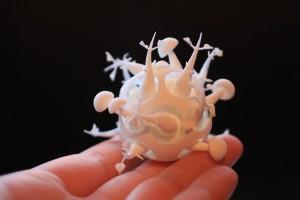A University of Eindhoven student of Industrial Design has just created her own modest version of a Star Trek-style replicator. While Chloe Rutzerveld’s machine, which she’s dubbed “Edible Growth,” won’t be cranking out extravagant snacks like Jean Luc Picard’s much-favored caviar anytime soon, there is a certain elegance to the croquette-like treats that issue from her Edible Growth 3D printer.
In collaboration with Netherlands-based, TNO (Netherlands Organization for Applied Scientific Research), an independent research association with centers across the globe, Rutzerfeld developed Edible Growth as a means of addressing the critical issues of food waste and the ever-greater demand for food in a massively overpopulated world. The impetus for this young designer was, it seems, less about creating a clever and novel culinary device and more about putting environmentally responsible food production into the hands of individuals.
The boom in home gardening, increasingly in urban areas, and the farm-to-table movement are reflective of a growing environmental consciousness that seeks to return agriculture from an industrial to a regional and, as much as possible, local level, to reduce “Big Ag’s” excessive and, in many ways, wasteful use of resources. Growing your own food or buying it from a producer nearby reduces the risks of food spoiling before it reaches your table and eliminates the demand for extreme measures like long-distance shipping, refrigeration, and other activities that draw on declining resources like water and fossil fuels.
Edible Growth is hardly poised to save the world, but it’s an ingenious start. The shell of the croquette is produced using a 3D printer. Layers of yeast, seeds, and spores are printed in a basket-like form reminiscent of intricate, lattice-work crusts of traditional pies and pastries. The process of “growing” the small pastry takes five days. The end result is a complete and rather pretty amuse-bouche from which spring edible plants–something like baby greens–and mushrooms from the small gaps in the pastry. A longer growing period intensifies the taste and scent of the food.
There’s nothing artificial about the ingredients and you print the individual “starters” on demand, so there’s no waste aside from one you and your fellow diners can’t finish. The Edible Growth 3D printer is small and the ingredients it requires are very nutritional–little space is required for this method of food production. While Edible Growth is at the appetizer stage of development, there’s little doubt that it will inspire innovation on a broader scale. Recently, the French company, Nestle, announced that it is working on its own, seemingly more elaborate version of the replicator, referred to as “Iron Man,” to be released widely in 5 to 10 years. However, there’s something quite charming in the relative simplicity–seemingly far less “Sci-Fi” than the Nestle project–of Rutzerfeld’s healthy and beautiful 3D-printed treats.
Let’s hear your thoughts on this very unique way of looking at food production, in the 3D printed Edible Growth forum thread on 3DPB.com.
Subscribe to Our Email Newsletter
Stay up-to-date on all the latest news from the 3D printing industry and receive information and offers from third party vendors.
You May Also Like
3D Printing Unpeeled: Orbex Investment, IndoMIM and HP, Ultrasonic Waves
INDO-MIM has bought three HP Metal Jet S100 printers, operating two in India and one in Texas. This is a win for HP because the company has deep experience in...
3D Printing News Briefs, April 3, 2024: Kickstarter FDM 3D Printer, Artificial Eyes, & More
In 3D Printing News Briefs today, we’re talking about an FDM 3D printer on Kickstarter, advancements in artificial eye creation, and 3D printed solenoids for electromagnets. Then we’ll move on...
Firestorm Gets $12.5M from Lockheed and Others to Automate Drone Production with 3D Printing
Firestorm Labs is advancing an initiative that has been a topic of discussion on our site for a while: automating drone swarm production. Drones are increasingly altering the landscape of...
3D Printing Leaders Team with Rivelin for Robotic Metals Post-processing
UK-based Rivelin Robotics is working on creating a manufacturing cell to automate the post-processing of metal 3D printed parts. If successful, this approach could reduce the costs of metal 3D...

































